RIVASTIGMINE PATCH - TRANSDERMAL
PHONETIC PRONUNCIATION: (riv-uh-STIG-meen)
COMMON BRAND NAME(S): Exelon
GENERIC NAME(S): rivastigmine
Uses
USES: Rivastigmine is used to treat confusion (dementia) related to Alzheimer's disease and to Parkinson's disease. Rivastigmine does not cure either of these diseases, but it may improve memory, awareness, and the ability to perform daily functions. This medication works by restoring the balance of natural substances (neurotransmitters) in the brain.
How to use RIVASTIGMINE PATCH - TRANSDERMAL
HOW TO USE: Read the Patient Information Leaflet if available from your pharmacist before you start using this medication and each time you get a refill. Follow all instructions for how to properly apply and use the patches. If you have any questions, consult your doctor or pharmacist. Apply the patch to the skin as directed by your doctor, usually once daily. Do not open the sealed pouch until ready to use. Open the pouch and remove the patch from the protective liner. Do not cut the patch. Apply the patch as directed to a clean, dry, hairless area on the back, upper arm, or chest. Remove the old patch first before applying a new patch. Do not wear 2 patches at the same time. Do not apply the patch to red/irritated/broken areas of skin or to areas where you have applied creams or lotions. Avoid applying it to areas where tight clothing may rub the patch off. You can bathe with the patch on. When changing your patch, remove the old patch, fold it in half with the sticky sides together, and throw it away out of reach of children and pets. Apply a new patch to a different area to prevent skin irritation. Do not apply a new patch to the same area for at least 2 weeks. If the patch falls off before it is due to be changed, apply a new patch right away and replace the new patch at the regularly scheduled time the next day. Do not try to reapply the old patch or use tape to keep a loose patch from falling off. Do not touch your eyes while you are handling the patch. Wash your hands with soap and water after each application. If the medication comes in contact with your eyes or if your eyes become red after handling the patch, rinse your eyes right away with water. Tell your doctor if the redness or other symptoms do not go away. Dosage is based on your medical condition and response to treatment. To reduce your risk of side effects (such as nausea and diarrhea), your doctor will start this medication using a lower dose of the patch and may increase your dose after 4 weeks. Follow your doctor's instructions carefully. Do not increase your dose or use this drug more often than prescribed. Do not apply more than one patch per day or leave the patch on for longer than prescribed. Your condition will not improve any faster, and your risk of side effects will increase. Use this medication regularly to get the most benefit from it. To help you remember, change your patch at the same time each day. If you do not use rivastigmine for 3 or more days in row, talk with your doctor before starting again. You may need to restart at a lower dose. Tell your doctor if your condition worsens.
Side Effects
Precautions
Interactions
Overdose
Images
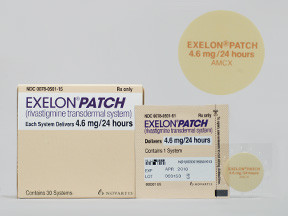
- color
- tan
- shape
- round
- imprint
- EXELON PATCH 4.6mg/24 hours AMCX
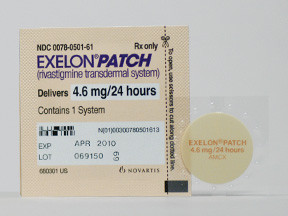
- color
- tan
- shape
- round
- imprint
- EXELON PATCH 4.6mg/24 hours AMCX
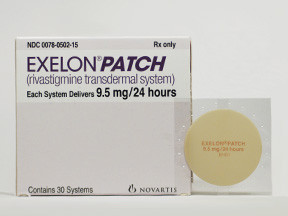
- color
- tan
- shape
- round
- imprint
- EXELON PATCH 9.5 mg/24 hours BHDI
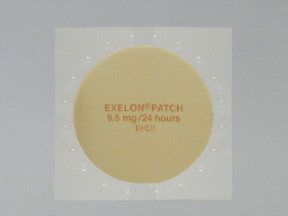
- color
- tan
- shape
- round
- imprint
- EXELON PATCH 9.5 mg/24 hours BHDI

- color
- peach
- shape
- round
- imprint
- Rivastigmine 9.5 mg/24 hours

- color
- peach
- shape
- round
- imprint
- Rivastigmine 13.3 mg/24 hours
Reviews
Faq for RIVASTIGMINE PATCH - TRANSDERMAL
- A Rivastigmine patch is a transdermal medication that is used to treat symptoms of mild to moderate Alzheimer's or Parkinson's disease. It works by increasing the levels of certain chemicals in the brain that are involved in memory, thinking, and overall cognitive function.
- Apply the patch to clean, dry, and hairless skin on the upper or lower back, upper arm, or chest. Avoid applying the patch to areas with cuts, irritation, or burns. Press the patch firmly in place for at least 30 seconds to ensure proper adhesion.
- The patch is typically applied once daily and should be changed at the same time each day. It is important to follow the dosing schedule prescribed by your healthcare provider.
- Common side effects may include nausea, vomiting, diarrhea, loss of appetite, weight loss, dizziness, drowsiness, headache, and skin irritation at the application site. If you experience severe or persistent side effects, it is important to contact your doctor.
- Yes, you can swim, bathe, or shower while wearing the Rivastigmine patch. The patch is designed to stay in place during these activities. However, avoid exposing the patch to excessive heat, such as hot tubs or saunas, as this may affect its effectiveness.
- No, you should not cut, alter, or damage the patch in any way. The patch is specifically designed to release the medication at a controlled rate, and altering it may result in improper dosing.
- If the patch falls off, replace it with a new one. If it has been less than 24 hours since you applied the previous patch, apply the new one immediately. If it has been more than 24 hours, skip the missed dose and apply the next patch at the regular time.
- The patch may take several weeks before you start experiencing improvements in your symptoms. It is important to continue using the patch as directed by your doctor, even if you do not notice immediate effects.
- No, you should not stop using the Rivastigmine patch abruptly without consulting your healthcare provider. Sudden discontinuation of the medication may result in worsening of symptoms. It is important to follow your doctor's instructions for tapering off the medication if needed.
Disclaimer
IMPORTANT: HOW TO USE THIS INFORMATION: This is a summary and does NOT have all possible information about this product. This information does not assure that this product is safe, effective, or appropriate for you. This information is not individual medical advice and does not substitute for the advice of your health care professional. Always ask your health care professional for complete information about this product and your specific health needs.
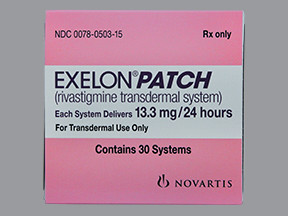
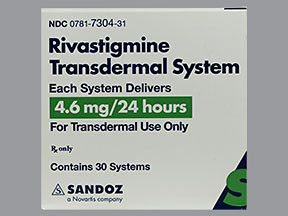
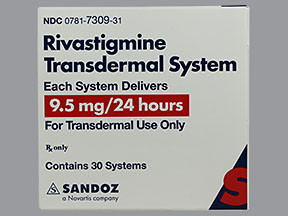
No Reviews Yet